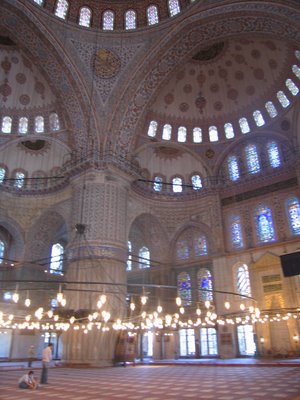Monday 1 October 2007
Saturday 21 July 2007
The View from Hamdi



Tuesday 17 April 2007
Galata Bridge
Friday 30 March 2007
Friday 16 March 2007
Saturday 10 March 2007
Yeni Camii (New Mosque)
 New Mosque and Spice Bazaar from Hamdi restaurant
New Mosque and Spice Bazaar from Hamdi restaurant New mosque (foreground), and Süleymaniye mosque on hill behind
New mosque (foreground), and Süleymaniye mosque on hill behind

Thursday 22 February 2007
Mısır Çarşısı (Egyptian Bazaar)


 Entrance to the Bazaar, 20 Nov 1990
Entrance to the Bazaar, 20 Nov 1990Wednesday 21 February 2007
Between the Grand Bazaar and Spice Bazaar - shopping streets
Sunday 4 February 2007
Sunday 28 January 2007
Istanblue




My friend Tuncay has a shop right in the wall of the Blue Mosque. We met Tuncay when we were living in Istanbul in the early '90s when he had a carpet shop in the Covered Bazaar. Several years ago he moved out to this location, which is really gorgeous. We have several kilims, sumaks and afshars bought from Tuncay, who like the best of carpet sellers is part psychologist, part philosopher!
 The view from upstairs at Tuncay's shop, looking out the little window.
The view from upstairs at Tuncay's shop, looking out the little window.Tuesday 14 November 2006
Blue Mosque





So many words have been written about this mosque, and of course, comparisons made betwen it and Aya Sofya (usually in the latter's favour), that it's pretty impossible to add more. I do love visiting here because it is a working mosque.
This Turkish style of mosque has been copied in one of Sydney's mosques - the Gallipoli Mosque at Auburn. It serves a mainly Turkish community.
Tuesday 10 October 2006
Aya Sofya
 Looking towards the Aya Sofya from the Blue Mosque.
Looking towards the Aya Sofya from the Blue Mosque. Interior gallery
Interior gallery
 View looking out from gallery
View looking out from gallery Aya Sofya 13 July 1989
Aya Sofya 13 July 1989
Arguably İstanbul's most famous building. There are a million photos of it, so in my most recent trip I tried to take some "different" ones, hence the dark spaces in the Gallery.
Inside is simply astounding, and I stare in awe at the architectural miracle that enabled this to be finished in 537. How does that central dome soar above with seemingly no support? [By the way, it has been replaced several times after earthquakes] The answer is that it is supported by 40 massive ribs constructed of special hollow bricks, made in Rhodes, resting on four huge pillars concealed in the interior walls. Almost 1000 years later, the great architect, Sinan, used the same technique in designing the Süleymaniye Mosque.
It was the greatest Christian church of all until 1453, when Mehmet the Conqueror turned it into a mosque. Being equally as significant to Christians and Moslems, I think Atatürk did the right thing turning it into a museum in 1934, so everyone can appreciate its magnificence.
Uncovering the mosaics (covered in plaster, but not destroyed, during the Islamic period) and restoration continues, and there is usually scaffolding, but that does not detract from a visit to this World Heritage site.
Saturday 7 October 2006
Topkapı Palace
Topkapı was begun in 1453 by Memhmet the Conqueror, and housed Sultans until Mahmut II (1808-1839), when the sultans built newer, more European style palaces along the Bosphorus. Along the way Topkapı was home to Selim the Sot, who drowned in the bath after drinking too much champagne, Ibrahim the Mad and Roxelana, the beautiful partner of Süleyman the Magnificent. And centuries of intrigue and espionage.
 Inside the Harem - the Imperial Antechamber (Hünkar Sofası)
Inside the Harem - the Imperial Antechamber (Hünkar Sofası)
 The area of the Fourth Court
The area of the Fourth Court
Friday 6 October 2006
Museum of the Ancient Orient
 A copy of the oldest peace treaty, the Kadesh Treaty, drawn up in the 13th century BC between the Egyptians and Hittites.
A copy of the oldest peace treaty, the Kadesh Treaty, drawn up in the 13th century BC between the Egyptians and Hittites.


These glazed panels once lined the processional street and Ishtar gate of ancient Babylon from the time of Nebuchadnezzar II (605 - 562 BC)


















